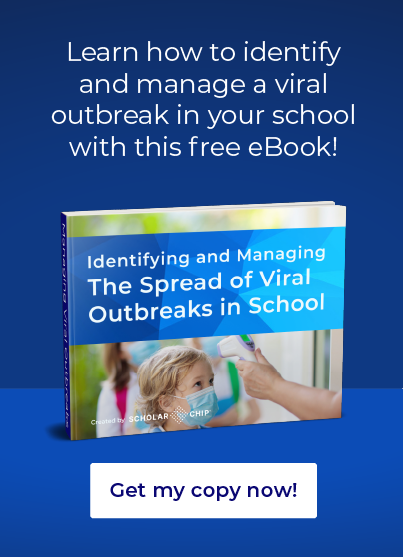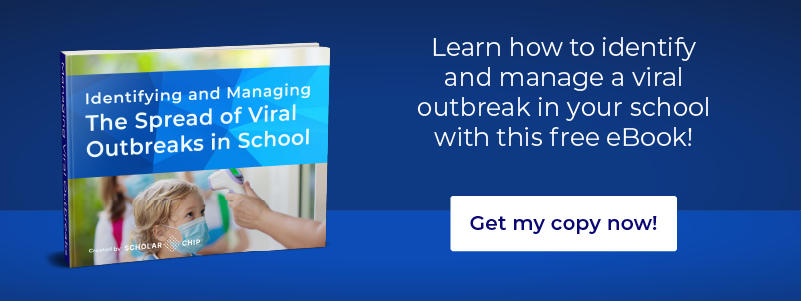Without precautions, a single student sick with COVID-19 can infect many others. Researchers are still unclear what creates a super-spreader incident, which is when many people whom an infected person comes into contact with get sick. However, they do estimate that about 10% of infected people are responsible for 80% of cases.
The concern about the ease with which COVID-19 can be transmitted is why keeping track of sick students is so important. Even before a student comes to school exhibiting symptoms of COVID-19, it’s essential to lay the groundwork to ensure that one sick student on campus doesn’t turn into many more.
Here are six strategies for more effectively keeping track of sick students.
Provide information to parents about keeping their sick students home from school.
Parents need to understand that their children won’t fall behind if they need to take days off from school because they’re sick. This fear may encourage parents to send ill children to school or have them return to classes too early.
Letting parents know that their students can keep up to date on their schoolwork is vital for promoting parental compliance. For instance, you may offer hybrid class sessions, where students can either watch their teachers’ instructions in a face-to-face classroom or through a virtual program, like Zoom.
Implement procedures that minimize the impact that a sick student could have on others.
Plan your year as if you will have a sick student on campus. This way, if a student does come to school sick, they will be less likely to infect others.
Strategies to prevent the spread of disease include:
- No sharing of class materials, like markers or pencils
- Handwashing stations and frequent sanitation of shared spaces like cafeterias
- Staggered class schedules to ensure socially-distanced classrooms
- Masks required for students and faculty
Develop a quarantine room where sick students can be taken if they have symptoms.
When a student is sick on campus, don’t wait until they’ve tested positive (or negative) to isolate them on campus. Create a room on campus where a sick student can be away from others. This room should also have a private bathroom. You may need several of these isolation rooms, as multiple sick students should not be quarantined together in one space. Ensure that your nursing staff has adequate PPE to transport and check on the student(s) in the room(s).
Immediately after a student is placed in an isolation room, their parents or guardians should be contacted to pick them up. Be sure that these adults will secure a COVID-19 test for the sick student. Furthermore, keep track of the student’s diagnosis, so you can move forward with the next strategies on this list.
Use technology that lets you monitor students’ whereabouts on campus.
If a student does come to campus sick with COVID-19, you should be able to track where that student has gone. Specifically, if a sick student comes into contact with others for extended periods, those people are more likely to become infected.
Before any children get sick, implement ScholarChip’s One Card and Secure Door Access tools at your school. First, install Secure Door Access card readers on all of your classroom doors. Then, each student is given a unique ID card that lets them unlock certain on-campus doors.
Not only does this precaution ensure social distancing in classrooms, but it also simplifies keeping track of sick students. You can use the data from the card readers to track precisely where students travel on campus. This, in turn, can help you prevent a major outbreak.
Set up a contact tracing team at your school.
Contact tracing is the best method for preventing a large-scale COVID-19 contagion. Specifically, these teams track down individuals with whom a sick student may have come into contact for long periods. Then, they ask those students, teachers, or staff to quarantine at home for two weeks, ensuring that they won’t spread the disease further.
Contact tracing is vastly simplified with tools like Secure Door Access card readers and One Cards. There is one more component that can help with digitizing contact tracing: ScholarChip’s Visitor Management system.
When a visitor comes onto your campus, they should check in at your Visitor Management Portal. You can then track when they’re on campus, how long they stay there, and with whom they come into contact. This way, if a parent volunteer comes into contact with a sick student, for example, you can alert them too.
Super-spreader COVID-19 carriers can infect many others with whom they come into contact. While you may not currently have a sick student on your campus, you should prepare as though you will. In addition to developing plans that will simplify contact tracing on your campus, you should also prepare to minimize the risk of disease transmission. With these strategies in place, you not only simplify keeping track of sick students but also lessen the impact that they may have on others.
The ScholarChip team is dedicated to helping school leaders maximize the safety and well-being of students and the entire school community.
Now sure what you should do to be able to identify and manage the spread of a viral outbreak in your school or school district? Feel free to chat with one of our school crisis communication specialists today!


